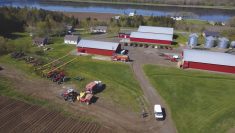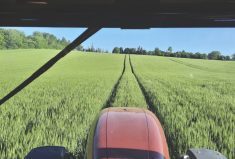Last year, Griffith Foods launched a pilot program to promote regenerative agriculture in Ontario wheat in partnership with Parrish & Heimbecker, Limited (P&H), Ontario Soil and Crop Improvement Association and the Sustainable Food Lab. Through the Advancing Regenerative Agriculture Farming Practices program, the global food company set out to support and incentivize the adoption of regenerative production practices to enhance the sustainability of wheat in their food source supply chain.
In 2024, 15 Ontario wheat farmers were invited to join the program, representing 3,919 acres of wheat production. The wheat was sold to P&H at a premium, acknowledging the contributions made by the regenerative practices the farmers applied to their acres.
“Our goal is to help farmers reduce the risk of adjusting their practices and help them gain the confidence to change where it makes sense,” says Sebastian Devis, North America regional sustainability lead for Griffith Foods, a global company with facilities in 30 countries.
Read Also

Sensing the soil: Root cell research finds ‘stress hormone’
Research into how root cells react to soil stressors could help plants better adapt to changes in their climate.
The pilot project is just one of many the company is conducting around the world, focusing on select crops and individual regions, including Brazil, Mexico and Thailand. Griffith Foods wants to obtain sustainably grown food ingredients and has set a goal of sourcing them from one million acres by 2030, with 500,000 of those acres in North America, including 30,000 acres of wheat grown in Ontario.
Working alongside participating Ontario farmers and their industry partners, Griffith Foods facilitated the adoption of sustainable practices, such as cover crops, minimum tillage, split nitrogen applications and precision agriculture. The validation and inspection portion of the program was conducted by industry and stakeholder partners who also worked with farmer participants to support peer-to-peer learning.
“Farmers know their business the best, and it would be presumptuous of anyone to tell them how to manage their acres,” says Devis, noting many of the farmers in the program were already following regenerative practices. “That’s why we want to work alongside farmers to help them change or implement new ideas that make sense for their farms and help them reduce the risk of doing so with knowledge, support and financial incentives.”
The Advancing Regenerative Agriculture Farming Practices program also serves to define a set of wheat production practices that fit into the Griffith Foods regenerative framework. The company has divided these practices into four groups based on environmental contributions: biodiversity, climate, soil and water.
Griffith Foods also acknowledges that regenerative practices benefit farm businesses economically and socially, and anticipates that, by supporting the adoption of new practices, farms will naturally become more resilient and sustainable.
The objectives of the pilot project were to understand the potential of regenerative agricultural practices in Ontario wheat production, determine the most attractive and beneficial practices, and identify barriers that would prevent farmers from signing on to the program. The inaugural year also served to benchmark metrics for the program.
Devis declared the 2024 pilot a success. In fact, the company has already signed on 38 farmers to the program for 2025, representing nearly 11,000 acres, or 30 per cent of the value of wheat Griffith Foods sources from Ontario.
“Our goal is to source from 30,000 acres of sustainably grown Ontario wheat as soon as possible,” he says.
Numbers aren’t the only metric being used to evaluate the program. Thanks to the launch of the pilot, P&H has hired a dedicated sustainability resource to support current and future program participants. Success was also measured in yield because that’s one of the most important factors that support the economic sustainability of farm businesses. Devis reports that Ontario wheat grown using regenerative practices through the program yielded 18.5 bu./ac. above the 2024 provincial average.
Looking ahead, the Advancing Regenerative Agriculture Farming Practices program will continue to support Ontario wheat farmers through learning opportunities, individual and peer-to-peer support, and financial incentives. Devis and his partnership team of industry stakeholders will be evaluating what they learned from the 2024 pilot year and continue measuring the impacts of the cropping practices being adopted.
“We understand that sustainability isn’t just a feel-good statement. It needs to make sense for a business to operate,” says Devis. “We are taking a long-term view to grow our business alongside farmers who are growing sustainable food so everyone can benefit together.”
















